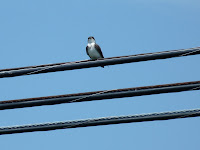June is one of the quietest times of year at Stratford Point. It is the time between spring and fall migration, with nearly every species present in Connecticut breeding. The birds are often out of sight in the nearby water and shoreline as boats, kayaks, and fishermen frequent the area on hot summer days. The
 upland areas are not filled with migrants quite yet. On the left, you can see a few of the fishermen who frequent the beach and east side of the point. In the far distance is Short Beach, filled with people on a hot day last week. One of the most engrossing aspects of the month is the various terns flying around Long Island Sound. While there were hardly any to be seen for nearly two weeks, a large group of Common Tern showed up between Milford Point and Stratford Point in the middle of the week. It was likely a nesting colony that had been destroyed since all of the birds were adults. We do not know what colony it may have been, though if you have any thought on the matter please leave a comment or send us an email.
upland areas are not filled with migrants quite yet. On the left, you can see a few of the fishermen who frequent the beach and east side of the point. In the far distance is Short Beach, filled with people on a hot day last week. One of the most engrossing aspects of the month is the various terns flying around Long Island Sound. While there were hardly any to be seen for nearly two weeks, a large group of Common Tern showed up between Milford Point and Stratford Point in the middle of the week. It was likely a nesting colony that had been destroyed since all of the birds were adults. We do not know what colony it may have been, though if you have any thought on the matter please leave a comment or send us an email.I had a Roseate Tern in this group of Common Tern as well. On Thursday, a couple hours before the now infamous Bridgeport tornado, I heard a Forster's Tern calling close to shore. One can often get lucky enough to see a Caspian Tern here. Last July our friend Charlie Barnard spotted a Black Tern that Miley and I got to enjoy close views of, too. If you can endure so
 me heat and humidity, come walk the perimeter of the sight to see if you can find one of these elusive terns or something rarer. While I said the fall migration has yet to begin, this juvenile Tree Swallow seems to be the start. It behaved exactly as the many migrant swallows do at Stratford Point - sat on the wires between the two main buildings, leaving only for a bit of feeding. This may simply be an example of natal dispersal, a young bird leaving the breeding grounds of its parents, and not true long-distance migration. Dispersal may also be the reason Twan and I enjoyed seeing an American Kestrel about 10 days ago. We know of no breeding pairs in the immediate area, and had not seen one for quite some time. Either way fall migration will be coming very soon - perhaps earlier this year. I will discuss this exceptionally early breeding year in another post this week.
me heat and humidity, come walk the perimeter of the sight to see if you can find one of these elusive terns or something rarer. While I said the fall migration has yet to begin, this juvenile Tree Swallow seems to be the start. It behaved exactly as the many migrant swallows do at Stratford Point - sat on the wires between the two main buildings, leaving only for a bit of feeding. This may simply be an example of natal dispersal, a young bird leaving the breeding grounds of its parents, and not true long-distance migration. Dispersal may also be the reason Twan and I enjoyed seeing an American Kestrel about 10 days ago. We know of no breeding pairs in the immediate area, and had not seen one for quite some time. Either way fall migration will be coming very soon - perhaps earlier this year. I will discuss this exceptionally early breeding year in another post this week.Photos © Scott Kruitbosch

No comments:
Post a Comment